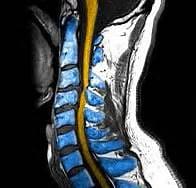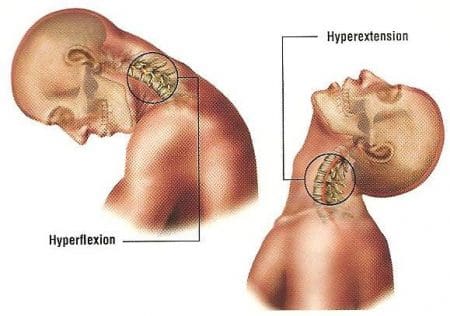Spinal cord injury (SCI) can have many causes. The way a person’s injury affects them can differ depending on the origin of SCI. SCI can generally be described as being ‘traumatic’ or due to a trauma, or ‘non-traumatic’ being due to other causes.
Spinal cord injuries occur in an assortment of ways. In adults, damage to the spinal column is usually involved and the cord is affected, bruised, stretched or compacted due to movement or an external force. Wear and tear on the spinal column, can lead to narrowing of the canal called stenosis. This results in pressure on the spinal nerves and the spinal cord, causing loss of function. In children, a spinal cord injury occurs by an over-stretching of the spinal cord.
Automobile accidents involving pedestrians or occupants, falls, sport-related accidents and diving into shallow water are considered to be the most common cause of traumatic SCI.
Spinal cord damage can be caused by the following kinds of injuries:
Flexion Injuries
Flexion injuries occur when there is a forcible forward movement of the head. This results in injury to the vertebrae in the neck (cervical) area of the spinal column. The vertebrae then impact on the spinal cord, causing damage. Spinal ligaments are often torn. These types of injuries occur in auto accidents.


Rotation Injuries
Rotation injuries occur alongside an injury, often where there is rotation of the spinal column. This leads to an associated injury of the spinal cord. Ligaments are often torn where the side rotation injuries happen in automobile accidents. They can also occur with people in motorcycle accidents, and wearing lap seat belts.
Compression Injuries
Compression injuries occur in diving accidents, where the force is transmitted through the head; or falls from a height, where the force is transmitted through the base of the spine or limbs. Impact causes the vertebrae commonly in the cervical or lower thoracic and lumbar region, to fracture into pieces and protrude into the spinal canal, damaging the spinal cord. The discs may be displaced and protrude into the spinal canal.

Hyperextension Injuries
Hyperextension injuries occur during an incident, such as a fall, where the neck is extended in a backward direction, stretching the cord. The spinal cord is damaged by the opening up of the discs and stretching of the ligaments if there’s minimal damage to the spinal column. This injury is often seen in people, and those injured in assaults and auto accidents. Hyperextension of the neck is the way children damage their spinal cords. The force of the trauma causes stretching of the spinal cord, although there’s often no or little damage to the spinal column.

Penetrating Injuries
Penetrating injuries occur when the spinal cord is penetrated by an object such as a knife or bullet. This type of injury can occur at any level of the spinal column and is often not associated with column damage.
Whether an injury is caused by events that are traumatic or non-traumatic, a person with a SCI has the ability to benefit from a variety of treatment options and rehabilitation, performed by a qualified and experienced healthcare professional. Research has indicated that the outcomes for people with a SCI are better if they have rehabilitation in a specialist unit as opposed to a general rehabilitation unit.

The scope of our information is limited to chiropractic and spinal injuries and conditions. To discuss options on the subject matter, please feel free to ask Dr. Jimenez or contact us at 915-850-0900 .
By Dr. Alex Jimenez
Additional Topics: Automobile Accident Injuries
Whiplash, among other automobile accident injuries, are frequently reported by victims of an auto collision, regardless of the severity and grade of the accident. The sheer force of an impact can cause damage or injury to the cervical spine, as well as to the rest of the spine. Whiplash is generally the result of an abrupt, back-and-forth jolt of the head and neck in any direction. Fortunately, a variety of treatments are available to treat automobile accident injuries.





